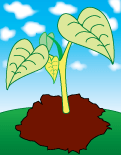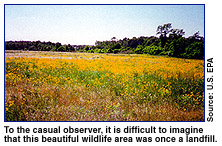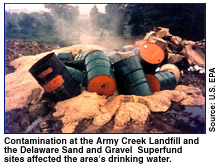
Plants and Revegetation
- Home
- EPA Presentations
- Principles for Ecological Land Reuse
- Soil Science
- Soil Amendments
- Terrestrial Carbon Sequestration
- Plants and Revegetation
- Why revegetate degraded lands?
- Why is it important to use native plants?
- How do invasive species affect an ecosystem?
- Further information and resources
- Growing Gardens in Urban Soils
- Ecosystem Services
- Creating Pollinator Habitats as Part of an Ecological Revitalization Project
- Act Locally
- Land Revitalization Assistance
- Case Study Profiles
- Publications, Resources, and Links
- Glossary of Ecological Land Reuse Terms

Why revegetate degraded lands?
It is possible to plant trees, shrubs, and other types of vegetation on sites that are in the process of being restored. In fact, many sites have been revegetated with a variety of plants. For example, grains, wildflowers, and other carefully selected flora were planted at the Army Creek Landfill in Delaware to create a meadow to attract migratory birds.
While ecological function should be considered early in the site remediation process to ensure it is properly implemented, revegetation is one of the final actions taken at a site. All site revegetation requires careful planning that considers soil conditions, plant species, and past experiences. When possible, plant species native to the area should be used (this is a recommended element of green remediation best management practices as well – visit the CLU-IN Green Remediation Focus area for more information on how to incorporate green remediation practices and reduce the environmental footprint of a revegetation project). Plans must address land uses that affect plant establishment. In addition, the post-revitalization land use will have a significant influence on designs, implementation, and costs.
Why is it important to use native plants?
Although a variety of plant species can be used in a restoration project, native plants should be used when possible. Some of the benefits that native plants have for a site being restored are:
- Native plants do not require fertilizers
- Native plants do not require pesticides
- Native plants require less water (no watering once established) than turf grass (lawns)
- Native plants provide shelter and food for wildlife
- Native plants are critical to a diverse number of pollinators
- Native plants reduce air pollution
- Native plants provide biodiversity and stewardship of our natural heritage
- Native plants save money
- Native plants can offer economic values (such as easily accessible food, natural medicine, herbs, and landscaping)
How do invasive species affect an ecosystem?
Healthy ecosystems are dynamic and ever-changing, but their changes occur within a range of natural variability. However, some kinds of non-native plants and animals can create havoc when, accidentally or intentionally, they are released outside their normal range into a new region. The gypsy moth, nutria, zebra mussel, hydrilla, sea lamprey and kudzu are examples of non-natives that have caused massive economic and ecological losses in new locations because the natural controls of their native ecosystems were not there.
Not all non-native species become pests, or even survive, in new locations. But when they do, they often displace a whole suite of native species to become dominant. They then take on new labels: invasive exotics, or non-native nuisance species, or simply, invasive species. Their impacts are insidious because they often invade the open space areas we have preserved for native flora and fauna, as well as farmlands, forests and suburbs. How big is the problem? Consider the following:
- Damages from invasive species, including only those damages that can be expressed in monetary terms, have been estimated as high as $138 billion per year. These damages affect agriculture, rangeland, forests, people's homes and yards, human and animal health, food supplies, fishing and boating, outdoor recreation, and many other areas;
- Invasive species are thought to have been involved in 70% of this century's extinctions of native aquatic species, and 42% of current endangered species are impacted significantly by invasive species;
- In January 2003 the Director of the U.S. Fish and Wildlife Service called invasive species "the biggest environmental threat to this country... something everyone needs to take very, very seriously."
It is increasingly important that managers of ecological restoration projects become aware of invasive species in their area, in both the aquatic and terrestrial environments. Aquatic invaders can have significant effects on water quality and aquatic ecosystem health due to the ways they affect bank stability and the volume of pollution levels in runoff. Non-native terrestrial plant species can crowd out and even replace native species in an ecosystem by using up and blocking access to resources such as soil nutrients, water, and sunlight. When possible, restoration projects should ensure that native species are used to repopulate degraded lands in order to avoid the problems described above.
Further Information and Resources
Native plants
- NatiVeg
Developed by the National Bobwhite Conservation Initiative, NatiVeg is a remote, Internet-based tool that works on desktops, laptops, tablets and mobile phones. Developed by NBCI and University of Tennessee Institute of Agriculture Information Technology Service and beta-tested by a variety of outside reviewers, NatiVeg is a database that, within the 25-state initiative's range (mid-west and southeast), delivers the proper native plant choices for a specific location and the user's specific purposes, whether wildlife, forage, biomass, pollinators, critical area planting, restoration or soil conservation. - Harper-Lore, B. and M. Wilson (Eds.). 2000. Roadside Use of Native Plants. United States Department of Transportation, Federal Highway Administration.
A comprehensive resource for land managers on the appropriate and wise use of native plants for planting and restoration projects. Information is organized by state and by specific natural vegetation regions in each state. - U.S. EPA. 2006. Revegetating Landfills and Waste Containment Areas Fact Sheet. EPA 542-F-06-001
This fact sheet provides information on revegetation of landfill surfaces for EPA site managers, consultants, and others interested in the revegetation of landfill surfaces. - U.S. EPA. Greenscapes
EPA's GreenScapes program provides cost-efficient and environmentally friendly solutions for landscaping that help preserve natural resources and prevent waste and pollution. - U.S. EPA. Green Landscaping: Greenacres.
Information and Resources on sustainable landscaping. - U.S. EPA. 2006. Landscaping with Native Plants Factsheet.
Frequently asked questions about using native plants for landscaping. Includes brief case studies on communities and private owners who have successfully used native plants in their gardens or landscapes. - Dumroese, R. Kasten; Luna, Tara; Landis, Thomas D., (Eds.). 2009. Nursery Manual for Native Plants: A Guide for Tribal Nurseries. Agriculture Handbook 730, Volume 1: Nursery Management. Washington, DC: Department of Agriculture, Forest Service.
Available free of charge from the U.S. Forest Service
This 17-chapter manual provides basic, easy-to-understand information for operating a native plant nursery. Intended for use by Native Americans, the manual is well illustrated with photos and line drawings, includes many real-world examples, and would be useful to anyone that is considering starting a native plant nursery, or refining their current operation. - University of Texas, Lady Bird Johnson Wildflower Center. Native Plant Information Network
An online database of more than 7,200 native plant species. - BeeSmart Polination Gardner App, North American Pollinator Protection Campaign
The BeeSmart™ Pollinator Gardner app allows users to browse through a database of nearly 1,000 native plants, and filter plants by what pollinators one wants to attract, light and soil requirements, bloom color, and plant type. This is an excellent plant reference to attract bees, butterflies, hummingbirds, beetles, bats, and other pollinators to the garden, farm, school and every landscape. - Forest Service Nurseries:
The following nurseries are operated by the U.S. Forest Service. They provide seeds, bare root, seedlings, and other vegetation used in ecological restoration projects:
- National Park Service Units:
- Plant Conservation Alliance
A coalition of government agencies and other scientific and conservation groups that is working to solve problems surrounding native plant extinction and habitat restoration. - Federal Native Plant Conservation Committee
A listing and contact information for government agencies, conservation organizations, and academic institutions that make up the Federal Native Plant Conservation Committee. - Seeds of Success
An interagency program coordinated though the Plant Conservation Alliance that supports and coordinates seed collection of native plant populations in the United States to increase the number of species and the amount of native seed that is available for use in stabilizing, rehabilitating and restoring U.S. lands.
- Center for Plant Conservation (CPC) Online Directory
The online CPC Plant Conservation Directory contains useful contacts in each state for information on rare and endangered plants, permit procedures, and government programs; botanists and other contacts in state Heritage Programs and Native Plant Societies; and a searchable database of organizations and experts active in the conservation of rare plants and their areas of expertise. - North American Native Plant Society
Non-profit association dedicated to the conservation of native plants in North America. The site features information on where to find native plants and seeds, publications, and links to related organizations. - Bringing Nature Home: How You Can Sustain Wildlife With Native Plants
Information and resources about using native plants in your home garden.
Invasive species
- CalWeedMapper
A project of the California Invasive Plant Council, CalWeedMapper is a new website for mapping invasive plant spread and planning regional management strategies. Users generate a report for their region that synthesizes information into three types of strategic opportunities: surveillance, eradication, and containment. - National Invasive Species Council
Website for the National Invasive Species Council, an inter-departmental council that helps coordinate all federal government activities related to invasive species (currently under construction). - National Invasive Species Information Center
A gateway for information and resources on invasive species. - The Nature Conservancy's (TNC) Global Invasive Species Team
TNC program dedicated to mitigating the damage caused by non-native species. Web page includes many resources, including invasive species guides, photographs, and news items. - National Park Service Plant Conservation Alliance – Weeds Gone Wild
Provides information for the general public, land managers, researchers, and others on the serious threat and impacts of invasive alien plants to the native flora, fauna, and natural ecosystems of the United States. - Weed Science Society of America (WSSA): Journal on Invasive Plant Science and Management
A new peer-reviewed journal published quarterly by the WSSA. The journal focuses on the biology and ecology of invasive plants, invasive plant management and restoration, ecological and environmental impacts, risk and/or cost benefit analyses, case studies, and updates on new invasive plants and policy, compliance, and regulatory legislation. It is available both on-line and in print. A subscription is required to view full-text articles online.






